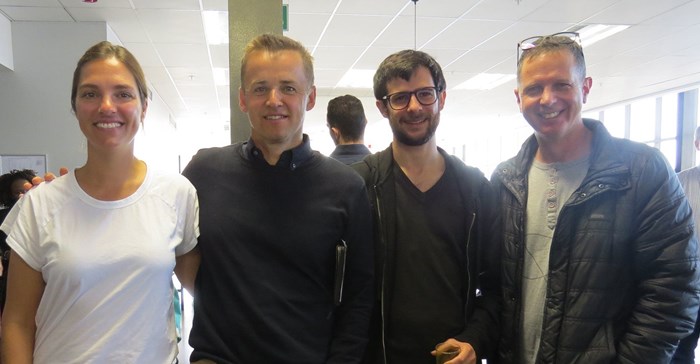
IAB Insight Series: Benchmarking digital excellence

Melissa Van Zyl, partner and head of strategy at M&C Saatchi Connect, and Robyn Campbell, managing director at Hello FCB, both presented on the day and later joined a panel discussion moderated by Paula Hulley, CEO of IAB SA and which included, Brian Reid, managing director, Kantar, Insights Division; Quanita Salie, media director at Meta Media; and Jessica van der Westhuyzen, digital and performance marketing manager.
For me, an interesting part of the discussion was Van Zyl's presentation on benchmarking.
- She identified three objectives that need to be implemented to create a successful campaign;
- Unpacking the idea of benchmarking being used to measure the success or failure of each one of these objectives;
- She also outlines the thought process behind ideas on how to achieve all of this in a cohesive manner.
She started off by stating that in the past there used to be a lot of focus on reporting on reach and the frequency of your campaigns. "That's a good start," she said, "but it has now gone to answer questions like; What does noting, reach and frequency actually mean for your business?"
Van Zyl went on to explain that the word benchmark means the norm. "It means what you should expect as a starting point and whether you are going to shoot under that or whether you are going to shoot over that or whether you are just going to try and achieve the norm."
She said that there are three themes that come through in every client brief and around every client's objectives:
- Brand consideration
- Recruitment
- Retention
For success in brand consideration, you'll see words like awareness, positioning, differentiation, recognition. In recruitment, it's a much more sophisticated ask. Just thinking about a brand and thinking about whether the brand is for you or not is much different from actually going into the store and spending your personal disposable income on that product.
Another way of recruiting – not only in sales – is in downloads, in call centre signups and registering often called leads. And the conversion space is really where this sits.
Success in retention is where you are getting your consumer to buy more and pay more for your brand. If people are talking positively about you, the value of your brand, the perception of it improves and you then can charge more for it.
Van Zyl said there are different tactics and strategies that are used in media planning and in marketing to achieve these different successes.
1. Brand consideration. At this stage, your relevance to your audience is at large. It's all about reach and it's all about reaching as many people in your target market as possible with a minimal amount of wastage. You don't want to spend money speaking to people who are not relevant to you.
Your campaign has to deliver on reach and association, which is usually through things such as sponsorship.
2. Recruitment. In media, there is something called frequency and in recruitment, you need an intense amount of frequency that creates a sense of hype and immediacy to get people to pay attention and to act. Targetted reach and high repetition what it's all about here.
3. Retention. This is far more intimate. Here you sacrifice reach for more targetting repetition. In retention, you should know about your customer. And here it's really about impacting them in a way that is going to move them to act and to become more invested in your brand.
Van Zyl said that at each stage, your messaging is quite different. "While brand consideration reaches a lot of people, the amount of sophistication, complexity and message here is quite generic because you need to appeal to a lot of people. If you are trying to be too relevant in this space, you can end up alienating people. So you want to be as single-minded as possible," she said.
At the recruitment stage, there is quite a lot of information that needs to go across. You need to remind people why and you need to tell them how. You need to give them the offer and you need to create the sale.
In retention, Van Zyl specified that, once again, there was lots of information here and a lot more detail, so you need introductions of innovation in your brand.
What channels deliver well on each of these types of tactics?
In brand consideration, it's broadcast media, sponsorships and also your celebrities and your endorsements because of the need for equity in your brand.
In recruitment, you need things that can deliver high frequency. "Radio is pretty good at frequency because it's got two prime times during the day; in the mornings and in the afternoon. So you can reach people repeatedly in one day. Point of sale is an ultimate reminder. Programmatic go hand-in-hand here with retargeting. You need to understand the frequency and the evolution of messaging in the digital space when you're trying to get people to act and do something. A good example is Superbalist and how the brand uses retargeting. SMS and to a degree Youtube sits here as well," Van Zyl said.
In retention, Van Zyl added that it's a lot about what you're actually doing on the ground. How are you delivering into the life of the consumer? So it's activation, it's events, it's social media communities, email and content.
In a nutshell, having a look at how traditional media and digital media works as an ecosystem to deliver the ultimate consumer journey throughout the brand's life stage.
Melissa van Zyl, Partner @mcsaatchiabel CONNECT and lead on the @iab_sa Benchmarking Project, kicks off the 8th Episode of the IAB Insight Series @Kantar to share insights on Benchmarking Digital Excellence #IABinsights #Fullhouse pic.twitter.com/8BrzNqbCZM
— IAB South Africa (@iab_sa) August 16, 2019
Digital hasn't congealed with the traditional media space
Van Zyl told us that what has happened is that in traditional media our measurements and our benchmarks were put in place through companies like (at the time) Millward Brown and (now) Kantar. Also organisations like Saarf (South African Audience Research Foundation) and Nielsen, which have looked at the effectiveness of different traditional inputs, and got out in the industry and basically said for free: "Here's the information, here are your norms and here are your benchmarks."
Meanwhile, digital has operated in a separate silo because of its ability to really show how things are delivering from an ROI perspective. So it is sitting in this space where it is probably the most powerful tool for measuring ROI but it hasn't congealed with the traditional media space.
Van Zyl said it's happening and it is especially happening because a lot of consumers' response to business is via digital channels. "And what I mean by that is not necessarily the sale," she said, "but it is just the initial response to an advertising execution that's gone out into the market or exposure."
She said that if you have spent money getting exposure out there, the least you can expect from an audience is some level of interest. An interest can manifest in search, in a session on your website, a call to your call centre, an SMS to your SMS line. And those are all your initial gateway responses to an advertising execution.
"What we've seen through response-based planning, where we've overlaid those sort of metrics against our media pressures is that in fact your television and your radio do have an impact on those response metrics."
Bring traditional and digital budgets together
So how do we link what's happening in digital to what's happening and garnered by broadcast media and bringing that together?
This is really an idea of how media uses benchmarks in planning. It's mostly to do with the weights you are looking at. What do these weights mean? And how much is it going to cost the business?
"We have different levels of activity and at those different levels, you desire different levels of exposure. And then what that relates to in terms of advertising ratings. How long should we maintain this sort of activity as a benchmark? And then more or less how much this is going to cost you," she said.
"What we've found is that there is a traditional media budget that's not included in the overall budget at the end. Digital gets its budget and traditional media gets the other budget to afford the metrics. And what we've been saying is that if you don't bring those two budgets together. If you don't look at what the money will buy you in terms of both your television and your digital, then you are wasting a lot of money because they work beautifully together."
Can't agree more! That's the end of my coverage of the event. If you'd like more information on these events, visit the IAB SA website. You can also register here or email Paula at ten.asbai@aluaP or Debbie at ten.asbai@eibbeD. Free for IAB SA members. Standard tickets cost R500.
About Juanita Pienaar
- #Newsmaker: Producer Eddie Chitate launches Africa's newest streaming platform - 4 Nov 2020
- #2020AfricaBrandSummit: The role of PR and communication during crisis - 14 Oct 2020
- #IABInsightSeries: Marketing partnerships in the digital economy - 12 Oct 2020
- #DoBizZA: Just Brands Africa gives back to SA by helping educate future leaders - 30 Sep 2020
- #Newsmaker: Deshnie Govender launches new podcast - 25 Sep 2020
View my profile and articles...
